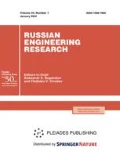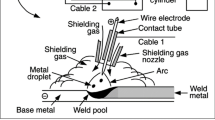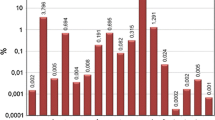Abstract
Experimental values are derived for the tribological characteristics of EN-GJV-400 cast iron, as well as its surfaces modified by melting, alloying with copper and nickel, and tungsten inert gas (TIG) welding in a high-frequency magnetic field. The latter process considerably improves the wear resistance.



Similar content being viewed by others
REFERENCES
Lapple, V., Drube, B., Wittke, G., and Kammer, C., Werkstofftechnik Maschinenbau: Theoretische Grundlagen und Praktische Anwendungen, Berlin: Europa-Lehrmittel, 2007.
Heck, K., Einfluß der Prozeßführung beim Umschmelzhärten auf die Randschichteigenschaften von Nockenwellen aus ledeburitischem Gußeisen, PhD Thesis, Munich, 1983.
Dieter, W., Harald, K., and Otto, L., Stahlguss- und Gußeisenlegierungen, Stuttgart: Deutsch. Verlag Grundstoffindustrie, 1992.
Bur’yanov, V.A., Improvement of service life of gas distribution mechanisms of engines for VAZ, Cand. Sci. (Eng.) Dissertation, Tolyatti, 1982.
M. I. Vladimirova, Optimal modifiers for cast iron with lamellar graphite, Cand. Sci. Dissertation, Moscow, 1993.
Aleksandrov, B.I. and Bobro, Yu.G., Optimal composition of wear-resistant cast iron, Liteinoe Proizvod., 1986, no. 8, p. 30.
Grigor’evich, N.I., Processes of graphitization and structuring in cast iron, Cand. Sci. (Eng.) Dissertation, Kyiv, 1995.
Beschichtung Hochbeanspruchter Bauteile: Verschleiß- und Korrosionsschutz, VDI-Berichte no. 866, Düsseldorf: VDI-Verlag, 1990.
Spiegel, K., Beiträge zur Elastohydrodynamik bei Nocken-Stößel-Paarungen, Clausthal-Zellerfeld: Tech. Univ. Clausthal, 1982, pp. 6–32.
Willermet, P.A., The composition of lubricant-derived surface layers formed in a lubricated cam/tappet contact II. Effects of adding overbased detergent and dispersant to a simple ZDTP solution, Tribol. Int., 1995, vol. 28, no. 3, pp. 163–165.
Kirschner, J., Tribologische und Kinematische Untersuchungen an Einem Nocken-Rollenstößel-Trieb, Karlsruhe, 1988.
Ayanoglu, P., Experimentelle Erfassung des elastohydrodynamischen Kontaktes in Zahnradgetrieben und Nocken-Flachstößel-Paarungen, PhD Thesis, Aachen, 1993.
Hofbauer, P., Nockenoptimierung für den Ventiltrieb von Fahrzeugmotoren, Aachen: RWTH Aachen Univ., 1981.
Czichos, H. and Habig, K.H., Tribologie Handbuch Reibung und Verschleiß Systemanalyse, Prüftechnik, Werkstoffe und Konstruktionselemente Braunschweig, Wiesbaden: Vieweg, 2001.
Shirzadov, F.M., Erhöhung der Verschleißbeständigkeit von Ventiltrieb-Werkstoffpaarungen mittels unterschiedlicher Randschichtmodifikationen, PhD Thesis, Berlin, 2012.
Author information
Authors and Affiliations
Corresponding authors
Additional information
Translated by B. Gilbert
About this article
Cite this article
Shirzadov, F.M., Sadykhov, A.I. Tribological Properties of EN-GJV-400 Cast Iron after TIG Welding in a High-Frequency Magnetic Field. Russ. Engin. Res. 40, 908–911 (2020). https://doi.org/10.3103/S1068798X20110180
Received:
Revised:
Accepted:
Published:
Issue Date:
DOI: https://doi.org/10.3103/S1068798X20110180




